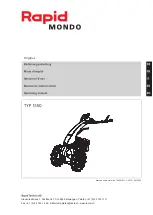
Doc no: 430-041-01
11 of 64
•
It is good practice, where possible, to mount the MRU as close as possible to the intersection of the
roll and pitch axes or at the centre of gravity (COG) of the vessel. This minimized the heave induced
by the lever arms (the physical 3-dimensional offsets between the MRU centre of rotation and the
acoustic centre of MBES). If the DT101
Xi
/ DT102
Xi
has an integrated MRU, the axis of rotation of
the MRU are indicated below in MRU Axes of Rotation ([mm] and inches): Figure 3-3 MRU Axes of
Rotation:
Figure 3-3 MRU Axes of Rotation ([mm] and inches):
•
Heave may also be measured using a high accuracy positioning system like Real Time Kinematic
GPS (RTK). If this system is to be used, the appropriate software should be configured during
mobilization.
•
The heading reference unit (like gyro or GPS based system) forward line should be orientated as
parallel as possible to the vessel heading fore / aft line. It should be securely mounted to the vessel
and not be subjected to excessive vibration. If a gyro is used, it is usually required to update the
gyro’s latitude, which can usually be done manually or using a positional input into the gyro unit.
•
Interface of the SIR unit with associated sensors is detailed in APPENDIX C.
•
The DT100 SIR unit has a number of options, for example, source of Pulse Per Second (PPS),
Heading source, MRU, SV source, etc. These are done by the changing of jumpers in the SIR unit
see APPENDIX C. The PPS pulse should be 3.5 V to 5 V (TTL) and be at least 1 millisecond in
duration.
•
Sensor power is supplied via the SIR box and can potentially be used by the following external
sensors (as well as the DT101
Xi
/ DT102
Xi
sonar head):
o
GNSS
o
MRU
o
SVS
o
Heading Sensor
These power supplies are set to 24 VDC by default, but a 12 VDC is available by the changing of
jumpers detailed in APPENDIX C.
•
There is a ground connector on the SIR unit and it is
essential
that this be connected to a good
source of ground on the vessel / vehicle. If the vessel is not metallic, it is advisable to safely dangle
a wire connected to the ground point on the SIR box in the water.
•
Communication with the SIR unit is achieved via an Ethernet port and User Datagram Protocol
(UDP). To communicate between the SIR unit and associated computer, the IP is achieved by setting
the IP address and subnet mask of the computer. The process is detailed in APPENDIX D.
•
Some modern lapt
op computers aren’t supplied with an Ethernet port and users will be required to
use an Ethernet to USB adapter. If this is the case, a high spec adapter, and the USB 3 port must be
used. If a discreet hardware port is not available, a high specification USB to Ethernet 3 adapter is
recommended. The TP-LINK Model UE300 appears to work well.
Summary of Contents for DT101Xi
Page 35: ...Doc no 430 041 01 35 of 64 APPENDIX A DT101Xi DT102Xi SPEC SHEETS DT101Xi...
Page 36: ...Doc no 430 041 01 36 of 64...
Page 37: ...Doc no 430 041 01 37 of 64...
Page 38: ...Doc no 430 041 01 38 of 64...
Page 39: ...Doc no 430 041 01 39 of 64 DT102Xi...
Page 40: ...Doc no 430 041 01 40 of 64...
Page 41: ...Doc no 430 041 01 41 of 64...
Page 42: ...Doc no 430 041 01 42 of 64...
Page 52: ...Doc no 430 041 01 52 of 64 Figure 6 7 Jumpers for Heading and PPS Selection...
Page 56: ...Doc no 430 041 01 56 of 64 Figure 6 8 Power Supply Voltage Option...












































